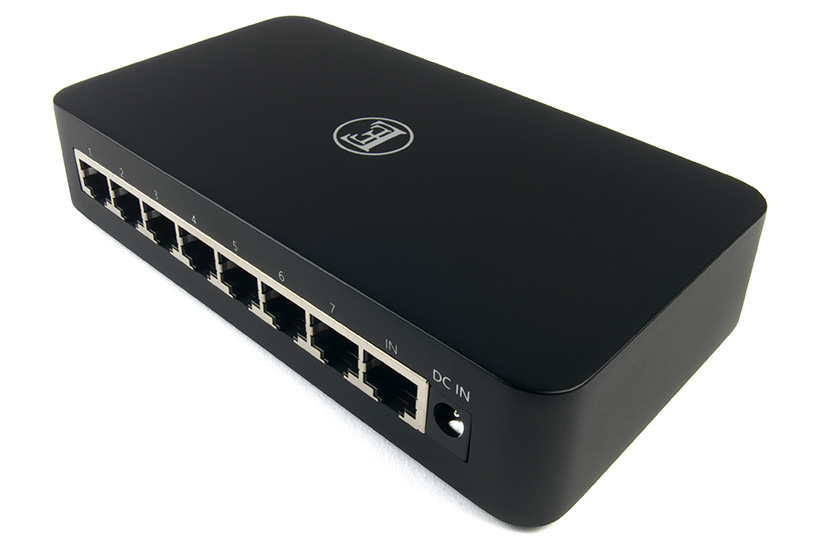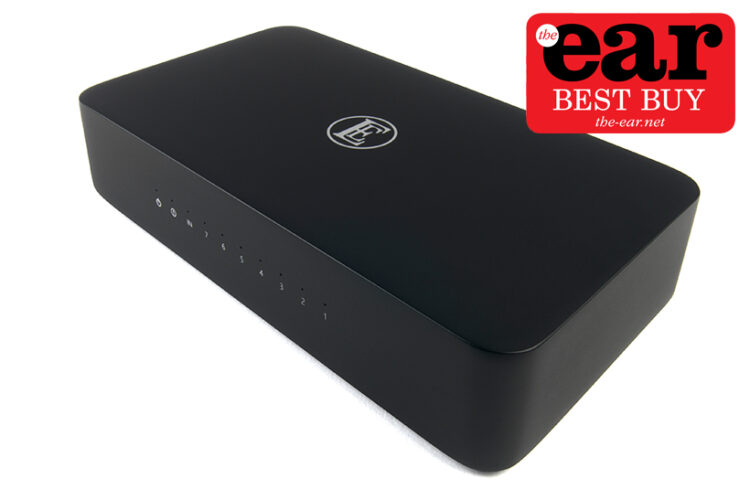It says something about the state of British manufacturing when a brand that once adorned trains and jet planes is used by a cable company on a network switch, but English Electric became part of GEC in the late sixties and like some of the great audio marques of that era it pretty well disappeared. Yet just as Leak has recently resurfaced in the IAG portfolio the Chord Company has resurrected English Electric in a product that while less than earth shaking is what a lot of streaming audio enthusiasts have been waiting for. They thought that the wait was over last year when Melco unveiled the S100 network switch but only the well heeled could actually afford it.
The English Electric 8Switch is a rather more sensible £450, which is still many times what an 8 port switch from Netgear or their competitors ask but this is not one of those in a nice box. It is a nice box though, cast aluminium with a faintly rubberised matt black finish and tiny LEDs instead of constantly flashing port lights. But it’s what’s inside that makes the difference between this and networking peripherals, the so-called core tech includes a TCXO (Temperature Compensation Crystal Oscillator) which is the clock that synchronises everything, this one has very high 0.1ppm accuracy. It is isolated against noise, which as you may know is the enemy of sound quality in digital systems, and has an electromagnetic interference absorber to reduce noise in the circuitry as a whole. The power supply is described as medical grade and sits in a plug top with a metre of cable, which isn’t very much for a device like this but was just enough for my system.

Chord also supply another cable, C-Stream streaming cable with RJ45 plugs, which at 75cm this did prove too short for my needs but it’s worth moving things around for if you don’t already have audio quality ethernet. One thing that struck me shortly after installing the 8Switch was how cool it runs, it uses under a watt in standby mode which is less than either of the switches I’ve used in the past. And while quite small at 15cm (6 inches) wide it’s heavy enough to hold its ground against the pull of several cables, the rubber feet must also help here because it weighs less than a pound.
My own network is based around a Cisco Catalyst 2960 S1 switch that connects two servers, a streamer, an Apple Airport Express for WiFi and a PC with cables from Melco and Audioquest on the audio components. My normal set up is to connect the streamer via the server, the switch is hooked up to the server which applies a degree of filtering and noise reduction before its connected to the streamer. I have found this to be beneficial with both Innuos and Melco servers regardless of whether the music files are on the server or coming from a service such as Qobuz. But to give the 8Switch a chance to make an impression I routed everything via the Cisco so that the signal had to pass through it prior to the streamer, then switched to the EE. This resulted in a marked increase in purity and extension of treble which in turn did great things for timing and imaging, the extra detail serving to better define leading edges and open up the harmonics which create a sense of air and scale. It really brought a sense of fresh energy to the music, opening up the soundstage and revealing more about the instruments in the mix, especially in tonal terms.

For the next test I went back to my usual switch–server–streamer arrangement wherein only control data and music streaming services pass through the switch, so theoretically all the switch can do when the files are coming from the server is reduce noise entering the system. Here the change was less dramatic in the first place but its effects became clear soon enough, the main one being an improvement in timing which became that much more precise and made the music distinctly more engaging. Which indicates that the 8Switch is pretty good at keeping noise at bay and that this has clear benefits for sound quality.
I also made the comparison using a song from Qobuz and here the EE switch once more proved its worth by enhancing the tunefulness of the track, this mainly being evinced by a clearer bass line and a cleaner overall presentation that suggests the noise floor had audibly dropped, which is clearly a good thing. My last contrast was between the 8Switch and a Netgear GS108 with a Longdog Audio/MCRU linear power supply in place of the standard issue wallwart. This proved to be the closest contest of all but the EE switch had the upper hand in terms of timing and the high notes were also a little sweeter, which enhanced the melodic aspects of the orchestral piece being played.

It may have English Electric on the case but the 8Switch has the key characteristics associated with Chord cables, namely great timing and coherence, which are crucial to making reproduced music sound realistic and enjoyable in the home. Add to this its conveniently compact size and high quality fit and finish and you have a product that anyone with a streaming source will find enhances their light entertainment. The fact that it has so little competition means that the English Electric brand could once more become a household name, at least among audio enthusiasts.


